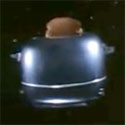Centrals vs. Obstructives
- spacetoast
- Posts: 174
- Joined: Mon Aug 10, 2009 4:23 pm
- Location: Golden, CO
Centrals vs. Obstructives
Are central apneas and hypopneas as serious as obstructive ones?
I'm a new layman to all this sleep stuff, but from what I've read an obstructive event goes down like this:
Brain: Uh...breathe
Airway:.....
Brain: Hey! Breathe, Please!
Airway:.....
Brain: Don't make me freak out, Airway!!!
Airway:.....
Brain: AHhh!!!! (dumps adrenaline, etc into the blood)
Airway: SNICKER SNORRRT!!! Huh? Wha? Oh, sorry...
Centrals:
Brain: La de dah
Airway: Uh...I'm open.
Brain: Wheeeee! Pretty colors
Airway: Uhm, I'm OPEN!
Brain: Wow, Judy from high school...lookin' good!
Airway: Look! Air! Lots n' lots of it!
Brain: Huh? Wha? Oh, sorry. Yeah, breathe.
So, obviously not getting oxygen to the brain is a serious matter and both events could cause a desaturation, but in the case of centrals, does the brain trigger all the fight or flight chemicals to be released too?
I have the Sandman HC auto and I get centrals, sometimes they are clumped together. The software separates the centrals from the obstructive events and I was wondering if I should be combining them to get a truer picture of my nightly AHI. Also, should I be worried about the centrals? Is there a time to worry and bring it up with my doctor? I've been on therapy for about 3 weeks now.
I'm a new layman to all this sleep stuff, but from what I've read an obstructive event goes down like this:
Brain: Uh...breathe
Airway:.....
Brain: Hey! Breathe, Please!
Airway:.....
Brain: Don't make me freak out, Airway!!!
Airway:.....
Brain: AHhh!!!! (dumps adrenaline, etc into the blood)
Airway: SNICKER SNORRRT!!! Huh? Wha? Oh, sorry...
Centrals:
Brain: La de dah
Airway: Uh...I'm open.
Brain: Wheeeee! Pretty colors
Airway: Uhm, I'm OPEN!
Brain: Wow, Judy from high school...lookin' good!
Airway: Look! Air! Lots n' lots of it!
Brain: Huh? Wha? Oh, sorry. Yeah, breathe.
So, obviously not getting oxygen to the brain is a serious matter and both events could cause a desaturation, but in the case of centrals, does the brain trigger all the fight or flight chemicals to be released too?
I have the Sandman HC auto and I get centrals, sometimes they are clumped together. The software separates the centrals from the obstructive events and I was wondering if I should be combining them to get a truer picture of my nightly AHI. Also, should I be worried about the centrals? Is there a time to worry and bring it up with my doctor? I've been on therapy for about 3 weeks now.
Re: Centrals vs. Obstructives
As I understand it, an occasional central is no biggie; an occasional central, as found by a home machine, may even be considered natural and normal. But some medicines and certain medical conditions can cause an inordinate amount of centrals that don't resolve with regular PAP therapies.
Although centrals don't cause the panic-type damage that obstructives can cause in OSA, having a lot of central apneas may still be an indication of an underlying issue that needs to be addressed. So it is worth talking to a doc about that in that case. And if someone continues to have too many of them on regular PAP therapy, that person may benefit from the use of a different kind of machine. This video helped me to understand some of the issues related to that:
http://www.vpapadaptsv.com/ResMed.htm
Although centrals don't cause the panic-type damage that obstructives can cause in OSA, having a lot of central apneas may still be an indication of an underlying issue that needs to be addressed. So it is worth talking to a doc about that in that case. And if someone continues to have too many of them on regular PAP therapy, that person may benefit from the use of a different kind of machine. This video helped me to understand some of the issues related to that:
http://www.vpapadaptsv.com/ResMed.htm
Re: Centrals vs. Obstructives
I just had my 6 month check up and i showed my doc a typical graph of mine with 6 or 7 events spaced throughout the night.
He said he thinks some of them might be centrals and the only way to find out would be another sleep study. So I am impressed by the fact your machine can distinguish between obstructive and central apneas as I do not think mine can (at least at the reporting level).
However since then I have been on my Elite Autoset and am now down to one or two AI events a night. I notice from the report graphs that when these events occur for around 10-14 secs and that the pressure is not raised at that time. This is making me think that the events are central as the machine has not detected an obstruction.
The doctor did mention to me that if my events were central in nature then i would need a very expensive VPAP machine.
I have another appointment in 3 weeks and wondering if he will go after the 1 or 2 events that I'm still having, I mean the goal is to eliminate ALL events is it not?
He said he thinks some of them might be centrals and the only way to find out would be another sleep study. So I am impressed by the fact your machine can distinguish between obstructive and central apneas as I do not think mine can (at least at the reporting level).
However since then I have been on my Elite Autoset and am now down to one or two AI events a night. I notice from the report graphs that when these events occur for around 10-14 secs and that the pressure is not raised at that time. This is making me think that the events are central as the machine has not detected an obstruction.
The doctor did mention to me that if my events were central in nature then i would need a very expensive VPAP machine.
I have another appointment in 3 weeks and wondering if he will go after the 1 or 2 events that I'm still having, I mean the goal is to eliminate ALL events is it not?
- spacetoast
- Posts: 174
- Joined: Mon Aug 10, 2009 4:23 pm
- Location: Golden, CO
Re: Centrals vs. Obstructives
Are you following this thread too?Uncle_Bob wrote:I mean the goal is to eliminate ALL events is it not?
viewtopic/t45011/better-understanding-o ... ected.html
From the discussion there, it seems that it is normal to have some shallow breathing during the night that may or may not look like central events. I don't know if your events fall into that category or not.
Of course, I'm trying to understand stuff that I have no experience with other than the bits I've gleaned off this forum. Maybe someone who has done more research than us can chime in about it, or provide some links for further study.
But, I would think it safe to say that getting rid of ALL events is probably not possible and that most people have some kinds of events during the night...Not just tens or hundreds per hour like some of us hoseheads!
And related to that, making a machine that could detect and identify exactly the events you are having probably doesn't exist either since we are all different in little ways and breathe slightly differently throughout the night.
Re: Centrals vs. Obstructives
I should have said ALL AI's i hear that some HI are acceptable especially using Resmeds algorithm.spacetoast wrote:Uncle_Bob wrote:I mean the goal is to eliminate ALL events is it not?
Re: Centrals vs. Obstructives
Very interesting, thanks for the link. This is why this site rocks!jnk wrote:As I understand it, an occasional central is no biggie; an occasional central, as found by a home machine, may even be considered natural and normal. But some medicines and certain medical conditions can cause an inordinate amount of centrals that don't resolve with regular PAP therapies.
Although centrals don't cause the panic-type damage that obstructives can cause in OSA, having a lot of central apneas may still be an indication of an underlying issue that needs to be addressed. So it is worth talking to a doc about that in that case. And if someone continues to have too many of them on regular PAP therapy, that person may benefit from the use of a different kind of machine. This video helped me to understand some of the issues related to that:
http://www.vpapadaptsv.com/ResMed.htm
Re: Centrals vs. Obstructives
My sleep doc says that centrals when just falling asleep are common; maybe it's the sleep stage transition that causes the brain to termporarily lose it's multi-tasking ability?
ResMed S9 range 9.8-17, RespCare Hybrid FFM
Never, never, never, never say never.
Never, never, never, never say never.
Re: Centrals vs. Obstructives
I think of it as the brain stepping on the clutch while it changes gears. But I think some of us have brains with a standard transmission and some of us have brains that are automatic.Muse-Inc wrote:My sleep doc says that centrals when just falling asleep are common; maybe it's the sleep stage transition that causes the brain to termporarily lose it's multi-tasking ability?
And some of us, especially in this forum, are just plain non-standard!
Re: Centrals vs. Obstructives
Uncle Bob --
Understand that your S8 AutoSet II does not respond to apneas that occur at a pressure of 10 or over. The algorithm assumes that they are centrals. It does, however, respond to flow limitations and snores at those pressures. Unfortunately, ResScan does not report these types of events. It never responds to hypopneas, regardless of pressure.
ResMed's A10 algorithm assumes that obstructive apneas are preceded by flow limitations and snores, and that responding to these, will proactively prevent apneas.
Understand that your S8 AutoSet II does not respond to apneas that occur at a pressure of 10 or over. The algorithm assumes that they are centrals. It does, however, respond to flow limitations and snores at those pressures. Unfortunately, ResScan does not report these types of events. It never responds to hypopneas, regardless of pressure.
ResMed's A10 algorithm assumes that obstructive apneas are preceded by flow limitations and snores, and that responding to these, will proactively prevent apneas.
_________________
| Machine: DreamStation BiPAP® Auto Machine |
| Mask: DreamWear Nasal CPAP Mask with Headgear |
jeff
- spacetoast
- Posts: 174
- Joined: Mon Aug 10, 2009 4:23 pm
- Location: Golden, CO
Re: Centrals vs. Obstructives
jdm, have you run across any literature that describes how a machine differentiates between hypopneas and flow limitations?
It seems to me that a hypopnea is a flow limitation.
It seems to me that a hypopnea is a flow limitation.
Re: Centrals vs. Obstructives
Or another way of saying that is to say that your S8 AutoSet II is always sure very quickly to respond to any indications of obstruction over 10 cm (those indicators, of course, being flattening and snores), but it is very smart not to respond to any events without those indicators above that pressure, since those events are most likely centrals, which should not be responded to. It isn't just a matter of what precedes events, it is also the indicators of the nature of the events themselves. (That approach may not work very well with someone who has had a UPPP, or something, but it should work pretty well for most of the rest of us.)jdm2857 wrote:Uncle Bob --
Understand that your S8 AutoSet II does not respond to apneas that occur at a pressure of 10 or over. The algorithm assumes that they are centrals. It does, however, respond to flow limitations and snores at those pressures. Unfortunately, ResScan does not report these types of events. It never responds to hypopneas, regardless of pressure.
ResMed's A10 algorithm assumes that obstructive apneas are preceded by flow limitations and snores, and that responding to these, will proactively prevent apneas.
If a hypopnea shows signs of flow limitation (in other words, it contains flattening), the machine should respond to the flattening at any pressure, because it responds to flow limitations (flattening), even when they are part of what gets labeled a hypopnea. Watching for those signs of obstruction keeps the machine from responding to "hypopneas," changes involving shallow breaths, that are not obstructive in nature.
So, does your machine respond to apneas and hypopneas above 10 cm? (Some might simply answer "no," since it doesn't want to respond to centrals. And in that context, it is the right answer, since technically it doesn't respond to the fact that an apnea occurred. It ignores that. But . . . ) My personal answer still is: Yes it does respond, but only to the ones involving signs of obstruction, since it is the signs of obstruction that actually trigger the machine to raise pressure.
Then again, I'm probably wrong again.
jeff
Last edited by jnk on Thu Sep 10, 2009 11:48 am, edited 1 time in total.
Re: Centrals vs. Obstructives
Flow limitations are reductions in flow that are not large enough to meet the definition of a hypopnea.
If I recall correctly ResMed defines an apnea as a reduction in volume of 80% or over, an hypopneas as 50% or over (but not enough to be an apnea) and a flow limitaion as less than 50% reduction.
If I recall correctly ResMed defines an apnea as a reduction in volume of 80% or over, an hypopneas as 50% or over (but not enough to be an apnea) and a flow limitaion as less than 50% reduction.
_________________
| Machine: DreamStation BiPAP® Auto Machine |
| Mask: DreamWear Nasal CPAP Mask with Headgear |
jeff
- spacetoast
- Posts: 174
- Joined: Mon Aug 10, 2009 4:23 pm
- Location: Golden, CO
Re: Centrals vs. Obstructives
Thanks for the info, guys.
Can you expound a bit on that, jnk?jnk wrote:If a hypopnea shows signs of flow limitation (in other words, it contains flattening)
Re: Centrals vs. Obstructives
I'll try, as long as you remember I'm a relative newbie at trying to understand this stuff myself.spacetoast wrote:Thanks for the info, guys.
Can you expound a bit on that, jnk?jnk wrote:If a hypopnea shows signs of flow limitation (in other words, it contains flattening)
Some use the expression "flow limitation" merely to mean that flow has lessened. Others use it in a more exact way to express a particular kind of breath, one that shows signs of being limited by obstruction. That shows up in the waveform as a flattened section of the wave. It is often the context that indicates what the writer had in mind, I think. Some use the words "flow limitation" to indicate that it is a shallow breath but not shallow enough to meet the home-machine definition of hypopnea. But the definitions change a bit when discussion the general concepts versus the way the events are measured in a PSG versus the way home machines measure breathing. The main thing is not to get too caught up in the technical definitions and to listen for the overall concepts. Most arguments on boards involve two people with two different definitions in their heads saying basically the same thing as they each try to make the other adopt the definition in his or her own mind. Those threads can be REALLY entertaining.
It is my observation that -SWS is one of the few people I've read on the message boards who grasps all the technical definitions but is still amazingly able to hear the newbie and the intermediate poster's intent and idea without being a stickler for enforcing the more precise definitions. That is a continual source of amazement to me.
Last edited by jnk on Thu Sep 10, 2009 12:33 pm, edited 1 time in total.
Re: Centrals vs. Obstructives
Me too! Always seems to sense what the poster is asking/commenting on even if in a tangled manner.jnk wrote:...It is my observation that -SWS is one of the few people I've read on the message boards who grasps all the technical definitions but is still amazingly able to hear the newbie and the intermediate posters intent and idea without being a stickler for enforcing the more precise definitions. That is a continual source of amazement to me.
Thanks to all the more experienced, knowledgeable members! Your shared info has helped me understand my particular varient of SDB as well as SDB in genreal and its treatment equipment. So many things I've have done differently had I know at diagnosis what I know now
ResMed S9 range 9.8-17, RespCare Hybrid FFM
Never, never, never, never say never.
Never, never, never, never say never.












